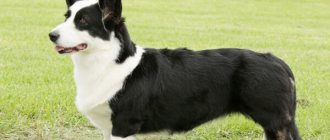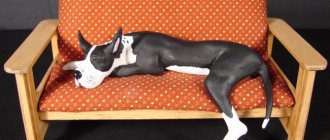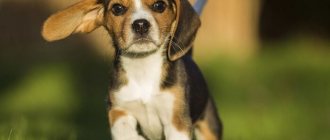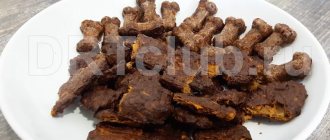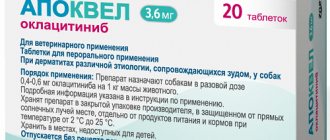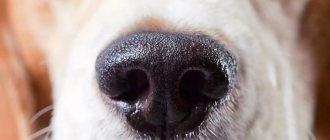Mostly, calluses develop in the elbow and hock joints (back legs). These calluses are dry, scaly, hairless and hard. Some are dark brown and black, and some are grey; it depends on the dog's skin and how long he has had the callus. Just like in humans, dog calluses are caused by the skin being in contact with something hard for an extended period of time, over time it becomes rough, cracked and sometimes requires veterinary attention. What are calluses on the elbows in dogs and what treatment is applicable to them can be read below.
What are corns and where do they form?
“Calls” is a common name for common calluses. These are areas of skin that have become rough and dried out due to constant friction against a hard floor, asphalt roads, etc. The development of the disease is facilitated by the action of negative environmental factors (cold, road reagents, allergens).
Most often, calluses form where constant friction of the skin is possible, or there is a high probability of other mechanical impacts on it (paw pads and skin under the collar, for example). They are detected (in addition to the places already mentioned) on the elbows, sternum, and groin area. However, the term “corns” usually refers to the formation of calluses on the pads of the paws.
Interesting! Breeders often confuse these formations on the skin with dermatitis, tumors, and manifestations of fungal infections.
Distinctive features of calluses:
- The general condition of the animal is normal.
- General and local body temperature is not increased.
- There is no severe pain. A dog can experience discomfort only in the case of fresh calluses.
- “Ripe” corns are hard, there are no signs of inflammation on the skin, there is no exudate, the dog does not pay special attention to these new growths (does not lick or chew them).
Pathogenesis
Owners very often ignore the condition of their pet’s elbow joints, making an appointment with a veterinarian only in crisis (emergency) situations. People simply forget that timely contact with a specialist and high-quality diagnosis greatly increases the effectiveness of therapy and allows:
- monitor the course of the disease;
- effectively predict the dynamics and development of the disease;
- provide quality treatment.
Bald spots (bald spots) in a Labrador Retriever occur for a number of reasons: let’s look at the basic mechanics of the origin and development of a skin defect:
Causes and predisposing factors
Very often, calluses on the paws form in dogs that often rest or sleep on some hard, hard surfaces. Such consequences can be caused by a poorly treated wooden or even concrete floor. Very often, dachshunds (especially the smallest varieties) suffer from “corns” right on the chest. These animals often rub their chests when “storming” stairs, thresholds, etc.
The appearance of calluses on the paws of working and hunting dogs, which sometimes cover enormous distances in a day, is typical. It is for this reason that there are special “boots” for paws. They are used by some hunters when hunting with a dog in mountainous areas with rocky outcrops. The same shoes are quite officially used by the police of those countries where service dogs are actively used.
As for predisposing factors, calluses are a common scourge of overweight dogs. This doesn't just apply to obesity. The paws of representatives of large and especially large breeds experience loads for which their limbs are not physiologically designed.
Recurrent alopecia of the lateral surface of the body in dogs
Clinical characteristics Canine recurrent flank alopecia (CRFA) is a skin disease of unknown origin, characterized by episodic body hair loss and often relapsing in nature. Previously, it had the following synonymous names: seasonal lateral body alopecia, seasonal growth hormone deficiency, idiopathic cyclic alopecia of the lateral body in dogs, cyclic follicular dysplasia and follicular dysplasia. CRFA is most common in dog breeds such as Boxers, Bulldogs, and Airedale Terriers, but is sometimes seen in other dog breeds. The disease can occur in animals of any gender and reproductive status. CRFA is characterized by non-scarring alopecia, which is most often concentrated in the thoracolumbar region. The lesions are usually symmetrical and bilateral, but occasionally dogs may only have one side of the body affected, or one side may be more affected than the other. Lesions caused by alopecia are ring-shaped or "geographic" in shape with well-demarcated edges. The skin is characterized by noticeable hyperpigmentation. The average age for the onset of alopecia is 3 to 8 years, but it varies (ranging from 8 months to 11 years). The onset of alopecia in males is not limited to the autumn and winter months; there is evidence of spring alopecia in females as well. And yet, if all cases are collected, in the Northern Hemisphere in most dogs the onset of alopecia occurs from November to March. The month of onset of clinical signs of alopecia does not depend on breed, age, gender or sexual status.
In many cases, spontaneous hair regrowth occurs within 3-8 months, and the coat is usually thick, although some dogs may grow darker hair on previously affected areas of the body (especially Boxers) or may have a golden-colored coat (aurotrichia). ), which is observed in some miniature schnauzers. But after several consecutive cases of alopecia, some affected dogs no longer regain full hair growth until the next episode of alopecia occurs. In the experience of the author of this article, approximately 20% of these dogs have had only one case of lateral alopecia in their lifetime. However, most dogs have had recurrent cases of alopecia over a number of years. In other dogs, a year has sometimes passed without recurrence of alopecia. The degree of alopecia varies; Some dogs lose the same amount of hair (in size and duration) from year to year, while others have larger areas of skin affected each year, or hair loss lasts longer, or both.
Causes and Pathogenesis The etiology of CRFA remains unclear. To date, the underlying causes, such as endocrinopathies, have not been confirmed. The seasonal nature and recurrence of CRFA suggest that the process is dependent on photoperiod. According to the author, CRFA occurs more often at higher latitudes (i.e., north of the 45th parallel). This suggests that CRFA may actually be caused at the genetic level by melatonin deficiency, which directly or indirectly (through its action on prolactin, androgen, estrogen or growth hormone, or a combination of all three) causes relapses of alopecia.
Treatment Although some drugs are mistakenly believed to be effective in treating CRFA, no treatment has yet been found to be effective. However, melatonin shows promise in the treatment of CRFA, as initial treatment trials have shown encouraging results. However, the unpredictable course of CRFA and spontaneous hair regrowth make the evaluation of any anti-CRFA therapeutic agent used to either prevent or reduce alopecia extremely difficult. Our only subjective knowledge is that a dog that has had three consecutive cases of CRFA has a high probability (>80% of cases) of recurrent alopecia in the following year.
The original trial, conducted to evaluate the effectiveness of melatonin in preventing the onset of CRFA, involved nine dogs that had previously had three or more recurrent episodes of CRFA (Paradis, 1995). Around the autumnal equinox (about two months before the next "expected" CRFA outbreak), each dog was given melatonin: three dogs received two subcutaneous injections of 12.5 mg melatonin in soybean oil (2.5 mg/ml; this formula is not commercially available form) at 2-week intervals, and six dogs were given three long-acting implants containing 12 mg melatonin subcutaneously (36 mg total, based on a 12 mg dose per fox). None of the dogs treated with melatonin in the fall had large patches of alopecia in the winter after melatonin treatment, as in previous years. Instead, two (large male Airedale Terriers) had discrete patches of hypotrichosis, 1.5-2 cm in diameter, that lasted less than a month and were quite different from the previous extensive patches of alopecia that typically lasted several months. In one old Boxer bitch who had had six consecutive cases of alopecia and had not completely recovered from the recent episode, there was no regrowth of hair in the relatively small area of alopecia that remained after administration of melatonin, but no new areas of alopecia appeared. It is also of interest that some dog owners reported that their pets began to grow thicker hair than usual after melatonin administration.
Since this initial study, some veterinary dermatologists have used melatonin in CRFA to either prevent recurrence or shorten the duration of an alopecia outbreak. In several cases, clear improvements have been achieved with either oral melatonin (tablets or capsules) or subcutaneous melatonin (water injections or implants). To document a true benefit of melatonin treatment for this disorder, dogs must be selectively treated before or immediately after the onset of alopecia (although the use of melatonin as a preventative treatment is limited given the 60-70% chance of relapse in any given year). A double-blind, placebo-controlled study is needed using oral melatonin as an alternative treatment for many animals with these clinical signs.
The danger of corns
Many owners may think that corns are purely a cosmetic problem.
Meanwhile, in practice they can cause serious health problems:
- If the calluses are large, they can cause pain to the animal when walking.
- In these same cases, the animal begins to constantly lick them and even gnaw them.
- If the callus cracks, a deep bleeding fissure often forms.
- In all the cases described above, damaged areas of the skin are quickly contaminated with pathogenic and conditionally pathogenic microflora, which leads to the development of inflammatory processes. If you do nothing at all, the dog may be left without a couple of fingers!
Should you take your dog to the vet?
Simple calluses are generally not a reason to visit the vet, as they are often a condition caused by repeated trauma to the elbow or other areas.
If we notice that our dog has calluses, we should periodically monitor the area to check for any wounds or changes that could indicate a skin infection. It is important to maintain hygiene in the affected area , and periodic washing with an antiseptic such as chlorhexidine may be helpful.
In case there are ulcerated areas, bleeding or changes in the affected skin, we should contact a veterinarian.
Methods for treating corns
In most cases, dealing with dry calluses is not too difficult:
- Aloe juice must be mixed with fish oil in a 1:1 ratio. It is better to do this by slightly heating the components. They are thoroughly mixed until a homogeneous liniment is formed. It is applied to calluses twice a day for about a week and a half.
- For the same purposes, propolis heated and softened in a water bath is used.
- A mixture of grated raw potatoes and onions (1:1) has a good antiseptic effect. This mixture is applied no more than once a day, since with excessive zeal the skin can become inflamed.
- Another option is a mixture of the same potatoes and honey (1:1). It is applied to calluses up to three times a day.
- In the summer, you can get by with dandelion juice, which is used to lubricate sores up to three times a day.
- If the skin of the calluses has already softened, but the dog gnaws them from time to time, additionally apply Levomekol. Not only does it have an unpleasant taste (this prevents the dog from licking its paws), but it also prevents the development of bacterial inflammation.
Infection or infestation (ringworm, mites, bacteria)
Ringworm, pests like scabies mites, and bacteria can all lead to infections that can eventually cause bald spots on your dog.
In addition to hair loss around the ears, eyes, mouth and other areas, your dog may have mite problems including oily skin, thickened skin, itching and inflammation. Symptoms of ringworm, a contagious infection of the hairy skin and nails, include circular or irregular hair loss, inflammation and infected crusts.
Although small ringworm lesions may go away spontaneously, they are contagious and require treatment. Ringworm is treated with topical antifungal medications. In severe cases, oral antifungal medications may be required.
Treatment for mites may require topical or oral medications, as well as antibiotics for secondary bacterial infections.
Which dogs are at risk for developing calluses?
Although no dog is immune from calluses, males suffer from this scourge more often than others, since their skin is usually less elastic compared to females. In addition, animals with short hair are more susceptible to the formation of calluses. If we compare large dogs with small ones, the former have calluses more often. As already mentioned, overweight dogs are at risk. In addition, calluses often plague dogs that do not receive enough vitamins responsible for the normal condition of the skin (especially A, C, E), as well as individuals that eat a poor and undiversified diet.
By the way, some dog breeds are predisposed to the formation of calluses: German, Caucasian, Central Asian and East European Shepherds, Labradors.
Prevention measures
The best prevention is careful adherence to the rules of keeping the animal - paw hygiene, organization of a healthy lifestyle, regular visits to the veterinarian.
To comply with these rules you must:
- promptly shorten overgrown claws;
- trim the hair growing between the toes and around the pillows;
- regularly deworm and destroy skin parasites;
- keep the dog clean;
- wash paws after walks.
Be attentive to your pet. The sooner you notice symptoms and take action, the sooner recovery will occur.
Diagnostics
Diagnosis of pododermatitis is a complex undertaking. The doctor needs to identify one from many possible causes and prescribe treatment in accordance with it.
Diagnostic algorithm:
- Examination of the dog's paws and interview of the owner. It is necessary to find out when and how the wounds appeared, as well as what the previous treatment was.
- Taking a scraping to identify mites.
- Microflora analysis to detect fungal infections.
- Diagnosis of allergies.
- Study of tissue characteristics for suspected hereditary diseases, epidermal necrosis and other hormonal or immune pathologies.
The disease should be diagnosed only after a thorough examination of all clinical signs. Some diagnoses are as simple as the presence of mites. And such as allergies can be identified only after excluding the possibility of a skin reaction to external or internal parasites. Hormonal pathologies are calculated based on the results of a blood test. Conformational pododermatitis in dogs is diagnosed based on the shape of the foot and only after other possible causes have been ruled out.
